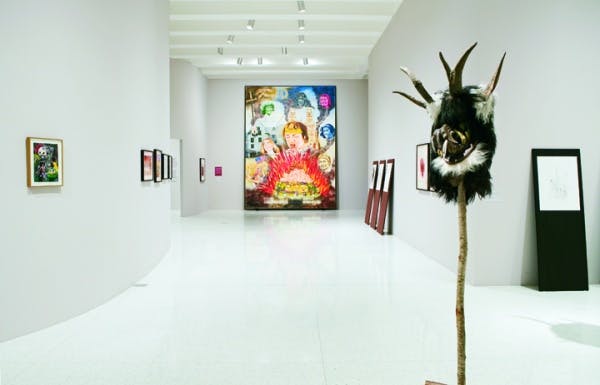
Cannibals & Headhunters
Cameron JamieBackyard teenage wrestlers, spook houses, eating contests, and a winter visitation by mythical beasts are just some of the fringe rituals Cameron Jamie explores through his art. Working across materials and media, he frequently collaborates with street-portrait artists and celebrity impersonators as well as musicians such as the Melvins and Japanese guitarist Keiji Haino. The resulting work conflates investigative strategies, autobiography, mythologies, vernacular traditions, and urban folklore to examine contemporary life, our fascination with the outlandish, and our need for escapism—what one critic has identified as “backyard anthropology” or what the artist calls “social theater.” Jamie’s work was included in the Walker’s 2003 exhibition How Latitudes Become Forms: Art in a Global Age.
The current exhibition, his first solo museum show in the United States, presents works ranging from drawings to sculptural objects to films created over the past 20 years, including examples of investigations around the notion of portraiture, self-representation, and collective identity, many of which have never been shown together. Also featured is the artist’s acclaimed film trilogy (BB, Spook House, and Kranky Klaus) along with selections from his photographic studies, ephemera, and archival material collected during the production of the films.
In 1998, Los Angeles–born Jamie began an objective examination of the backyard-wrestling phenomenon in Southern California, which led him into an ongoing investigation of folkloric reenactments, horror amusements, or what he describes as “the different types of ritualized social theatrics in America.” Shot in black-and-white Super 8, BB (2000), part of the Walker’s collection, focuses on teenagers in backyards across the San Fernando Valley as they jump off roofs and throw chairs at each other in an homage to televised wrestling heroes. The second film, Spook House (2003), is set in a working-class suburb of Detroit as residents construct haunted houses before Halloween. With the eye of an anthropologist, Jamie documented residents transforming homes, lawns, and abandoned structures into spook houses and cemeterylike settings. The final film of the trilogy, Kranky Klaus (2002–2003), chronicles the pagan celebration of Krampus in a snowbound village of Salzburg’s Bad Gastein Valley in central Austria, where each year on December 6, villagers congregate in homes awaiting a cortege of mythical elves and men dressed as horned, hairy beasts led by an elder bishop. Their performed grotesque ritual of “accepted” violence provides the cathartic experience of relieving daily abuses.
The humanistic quality of Cameron Jamie’s work, his collaborative practice, and his deliberate long-term engagement with his subjects bring to mind the tactics of “cine-ethnography” introduced by ethnographic filmmaker Jean Rouch (1917–2004), a pioneer of cinéma vérité. Immersing himself in peripheral elements of contemporary culture, Jamie becomes an ethnographer in search of alternative strategies for understanding and interpreting the layers of our knowledge and cultural structures.
| status | Copy #1 (2028): in |
|---|---|
| genre | Art » Artist Monographs |
| publisher | Walker Art Center |
| publish date | 2007 |
| popularity | checked out 0 time(s) |